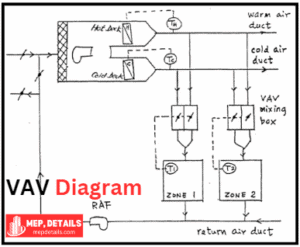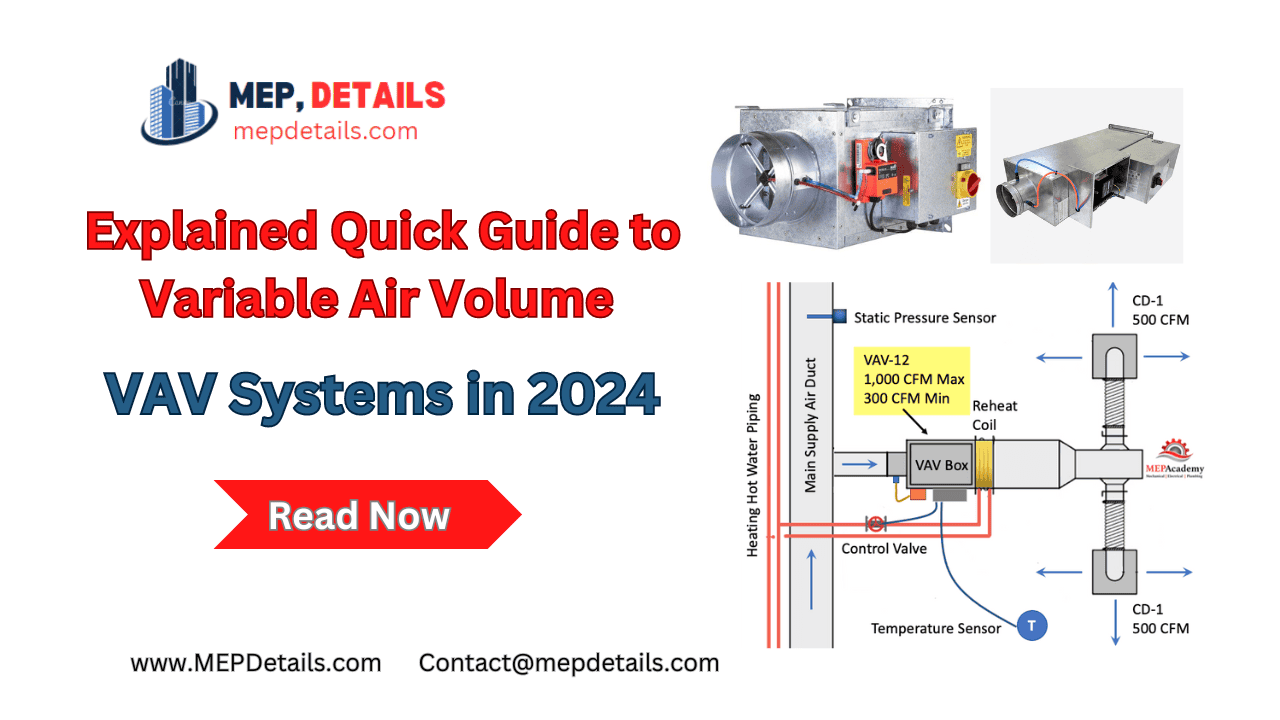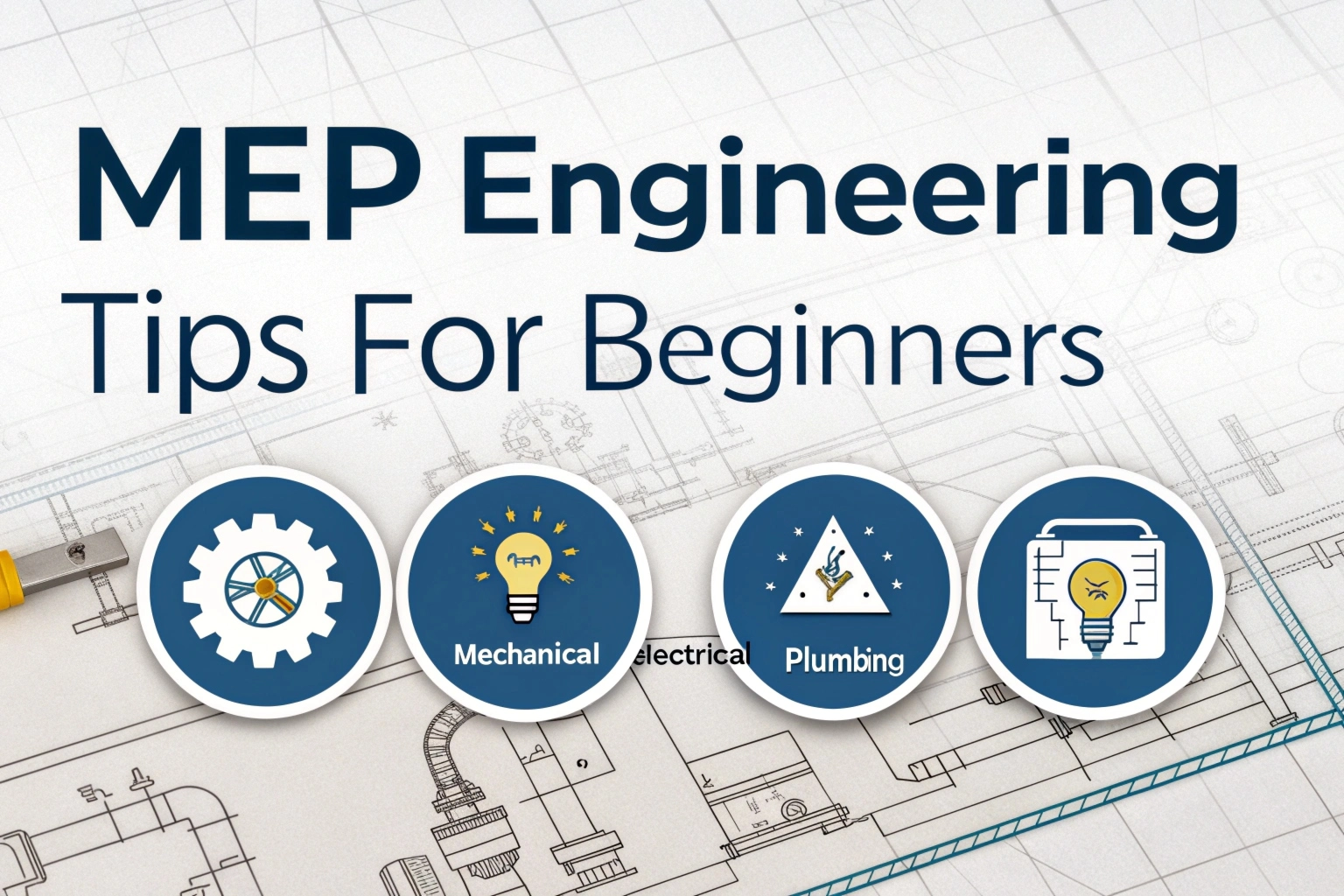Variable Air Volume VAV systems play a critical role in contemporary HVAC design, especially in commercial buildings. These systems are designed for energy efficiency optimization and at the same time keeping comfort level across different zones. This article discusses how VAV systems work, their components, control strategies and zoning techniques.
What is a VAV Systems?
A VAV system is an HVAC solution that adjusts the airflow (measured in Cubic Feet per Minute or CFM) to meet the heating and cooling demands of individual spaces within a building. Unlike constant air volume systems where there is fixed delivery of air flow, VAV systems adjust the volume of air supplied based on specific needs of each zone. Such adaptability results in substantial energy savings as well as increased comfort.

Components of a VAV Systems
There are several key components that constitute a typical VAV system:
- VAV Boxes: These regulate airflow to specific zones according to temperature readings from sensors.
- Air Handler: It conditions the air before it reaches to the VAV boxes through a process that is marked by an unswerving temperature but with changing airflow depending on demand.
- Temperature Sensors: The sensors measure temperatures of environment and send feedbacks to the Vav boxes.
- They regulate fan speed at which the Air handler operates according to general demand emanating from vav boxes.
How VAV Systems Operate
The operation of a typical variable air volume system can be presented into two levels of airflow control:
- Zone Level Control: Each zone has its own temperature sensor which controls airflow using each respective Vav box .In the modulation process, Vav box does either by opening or closing its damper.
- System Level Control: The overall flow rate from all interconnected vav boxes determines how much output is need from this device i.e., air handler. Consequently, an air-handler has to step up its performance when a lot of cooling is needed in more areas than before and reduce output when demand falls.

The Role of VAV Boxes
VAV boxes are core to the functionality of VAV system. They have dampers that regulate airflow according to the signals received from their temperature sensors. The operation of a typical Vav box includes:
- Actuator Movement: In response to controller commands, digital, pneumatic or electric actuator adjusts the damper position.
- Airflow Measurement: These devices measure total pressure and static ones in every vav box to help determine flow rate.
- Reheat Coils: Some vav boxes come with reheat coils used for boosting heating when need arises especially in case of external zones.
Understanding Zoning in VAV Systems
Zoning is crucial to designing a Variable Air Volume (VAV) system. It involves dividing a building into separate areas each with its own VAV box so as to improve energy efficiency and comfort levels within such spaces. Below is an explanation of how zoning works:
- Load Profile Consideration: Each zone should have a similar heating and cooling load profile allowing for efficient temperature regulation.
- Cost Efficiency: Reducing the number of VAV boxes can result into lower costs associated with material, labor and control systems.
- Exposure Management: Typically, zones are grouped based on solar exposure since portions of buildings will experience different heating/cooling demands throughout the day.

Modes of Operation in VAV Systems
VAV systems have 3 basic modes which are;
- Cooling Mode: In this situation, the cooling demand is met by modulating the VAV damper from a minimum position (typically 30% open) to 100% open.
- Dead Band Mode: This mode neither requires heating nor cooling and its damper remains at the minimum position to satisfy ventilation needs.
- Heating Mode: During this setting, the VAV damper stays at a minimum position while the heating hot water valve opens so as to meet the heating load.
Energy Efficiency and Control Strategies
VAV systems are designed with energy efficiency in mind, primarily when combined with variable frequency drives (VFDs). Two main control strategies are commonly employed:
- Constant Static Pressure Control: This practice involves use of pressure sensor installed in main supply duct for maintaining constant pressure level. When VAV boxes close, then there is an increase in pressure consequently forcing fan speed down by adjusting VFD.
- Static Pressure Reset: As per some regulations, adjusting static pressure to a lower level results into energy savings and better performance under changing demand conditions. just-in-time delivery
Conclusion
HVAC technology has been advanced by Variable Air Volume systems to give efficient solutions for heating and cooling management within commercial buildings. By grasping the components, operation as well as zoning strategies that can assist engineers designing their system for meeting all modern architectural requirements at maximum energy usage.
The rising demand for sustainable building practices means that implementation of VAV systems will remain key towards creating comfortable energy-efficient environments.
FAQs
1. What is a VAV in HVAC system?
A VAV (Variable Air Volume) system controls the airflow to different zones in a building, adjusting it based on the required temperature.
2. What is the difference between VAV and VFD?
Answer- VAV controls air volume in different zones, while VFD (Variable Frequency Drive) controls the speed of motors, typically for fans or pumps, to adjust the airflow or water flow in HVAC systems.
3. What is CFM in VAV?
Answer- CFM (Cubic Feet per Minute) is a measurement of airflow volume in a VAV system, indicating how much air is being delivered to a space.
4. What is the difference between VRF and VAV?
Answer- VRF (Variable Refrigerant Flow) controls refrigerant flow to different zones, providing heating and cooling, while VAV controls air volume in zones to maintain temperature.
5. How do VAV dampers work?
Answer- VAV dampers modulate the airflow to different zones by adjusting their opening, based on the demand for heating or cooling.
Read More – Ahu-air-handling-unit-design-basics-a-beginners-guide











